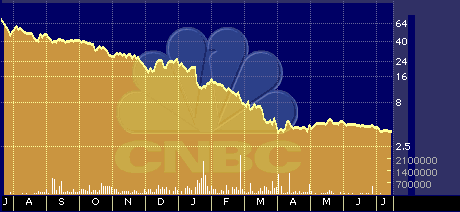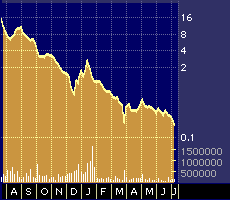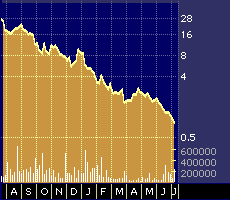
Selectica IPO Leaps Higher on First Day
Selectica IPO Leaps Higher on First Day
by Hal Plotkin
Silicon Valley Correspondent
Analysts see a bright future for Selectica Inc. {SLTC}. Investors seem to agree, bidding up the stock on its opening trading day.
San Jose, California-based Selectica is generally regarded as one of the four leading providers of Internet selling-system software, along with Calico Commerce Inc. {CLIC}, also based in San Jose; Waltham, Mass.-based FirePond Inc. {FIRE}; and privately held Trilogy Software Inc., based in Austin, Texas.
The stock opened at 97, after pricing its 4 million share offering at 30 a share late Thursday, above a revised pricing range of 23 to 25 a share and well above its initial filing range of 9 to 11 a share.

Selectica Post-IPO Stock-Performance Chart
Selectica’s customers include BMW, Hewlett-Packard Co. {HWP}, Samsung, Siemens AG {SMAWY} and 3Com Corp. {COMS}, among others.
“They’re very good,” says Eric Schmitt, an analyst with Forrester Research, based in Cambridge, Mass. “The problem they’re solving is actually quite difficult. It’s not easy for another company to do what they do. They have an advantage there that can be preserved.”
“They’ll probably do very well,” agrees Ken Vollmer, an analyst with the Giga Information Group, based in San Jose, Calif. “We’re at the early stages. The vast majority of companies in the U.S. are just starting to seriously look at this type of software.”
The analysts say Selectica’s stock will probably fare at least as well as the stocks of Calico Commerce and FirePond. Longer term, they add that by staying focused on providing software that helps companies sell products online, Selectica could become the pick of the litter among smaller B2B e-commerce enablers.
Calico went public on Oct. 6, with shares initially priced at 14. Rival FirePond went public on Feb. 3, with shares priced at 22.

Calico Post-IPO
Stock-Performance Chart

FirePond Post-IPO
Stock-Performance Chart
Unlike those companies, however, Selectica appears to be sticking very close to its knitting. The firm hasn’t wavered from its original mission: developing and selling software that helps other companies configure and sell complex products over the Internet based on individual consumer preferences.
“Their piece of turf is the high-end,” says Chris Selland, vice president for e-business research at the Yankee Group, based in Boston. “They’re somewhat smaller than the other guys, but they’ve won some big deals.”
“Take a look at BMW’s Web site, where you can build your own car,” Schmitt says. “If you think about it, it’s much more than just sales. The market research that can be fed back into product development from a site like that is critical, priceless information. Clearly, there’s a valuable deliverable there.”
Selland is also impressed with Selectica’s emphasis on Internet-based sales-automation software. He acknowledges that some companies may prefer to buy all their Internet and enterprise software from a single vendor. That is often the main selling point emphasized by the largest competitors, such as Baan Co. N.V. {BAANF}, Oracle Corp. {ORCL} and SAP Aktiengesellschaft {SAP}, all of which offer a fuller, though some say less robust, suite of online business-software applications.
Selland says the online selling solutions sold by such firms remains significantly less sophisticated and powerful than the technology pioneered by Selectica.
“Selling is one area where companies don’t want to have to compromise,” Selland says. “Selling is the most important thing for most companies. They’ll go with Selectica, because they have a best-of-breed product focused on selling. Oracle has a similar module, but it’s not their specialty.”
Meanwhile, smaller competitors Calico Commerce and FirePond have, likewise, begun to move beyond their roots in Selectica’s “configuration management” market, which is now more commonly called “guided selling.” Both companies have more recently been trying to widen their footprint by offering other products, ranging from Web-design services to assistance with online-marketing programs.
“Calico and FirePond have loftier goals,” Schmitt says. “The compelling value proposition for Selectica is their sophisticated active selling system that mimics the behavior of a good salesperson. They’ve made a decision to concentrate on that and not go after the whole platform. It’s less risky, in that it gives them less ground to cover. But it’s more risky once the consolidation starts.”
Like most analysts, Schmitt says he expects to eventually see a rising tide of mergers and acquisitions between and among e-commerce enabling firms.
“Down the line we’ll see more pressure to get a single vendor to handle all of this,” Schmitt adds.
“We’ve still got a ways to go before we get to the consolidation phase on the B2B side,” Vollmer says. Like Schmitt, Vollmer says he doesn’t expect to see much action on that score this year.
In the meantime, “it’s very much a horse race between these companies,” Selland says. “And there is plenty of opportunity for all of them.”
Selectica posted a loss of $7.5 million on revenue of $4.6 million for the six months ended Sept. 30, as compared with a loss of $3 million on revenue of $735,000 for the same period a year earlier.


